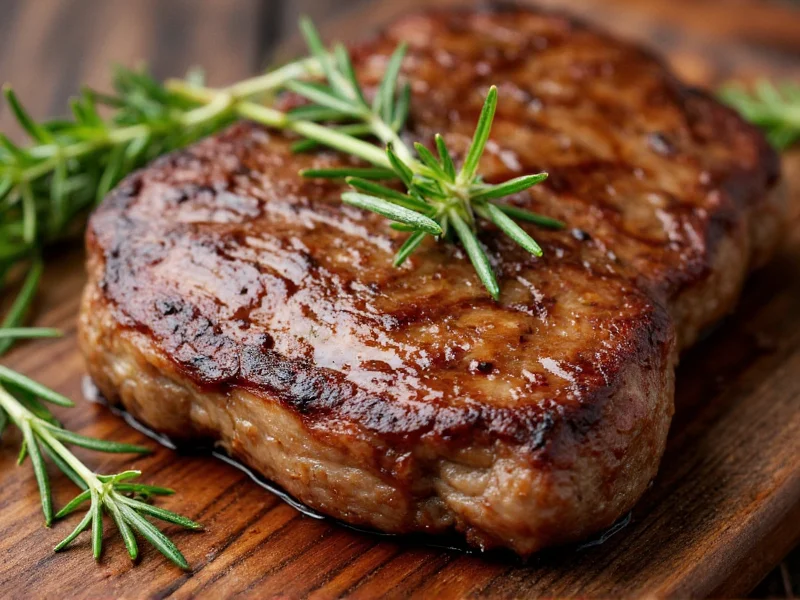Choosing between thyme and rosemary when cooking steak isn't just personal preference—it's a science of flavor chemistry meeting culinary technique. Both herbs belong to the mint family but interact differently with beef's fat composition and Maillard reaction compounds. Understanding these interactions transforms your steak from ordinary to extraordinary.
The Flavor Science Behind Herbs and Steak
When cooking steak with thyme or rosemary, you're leveraging specific volatile compounds that react with meat proteins. Rosemary contains camphor and 1,8-cineole, which bind exceptionally well with beef's fat molecules during high-heat cooking. Thyme's thymol and carvacrol offer more delicate aromatic notes that shine when not subjected to extreme temperatures.
Professional chefs understand that the cut of steak determines which herb will enhance rather than overwhelm. This knowledge separates adequate steak preparation from truly exceptional results when you cook steak with thyme or rosemary.
Thyme vs. Rosemary: Strategic Selection Guide
Not all steaks respond equally to these herbs. Consider these factors when deciding how to cook steak with thyme or rosemary:
| Factor | Choose Thyme When... | Choose Rosemary When... |
|---|---|---|
| Steak Cut | Filet mignon, flat iron, hanger steak | Ribeye, New York strip, porterhouse |
| Cooking Method | Pan-searing at medium heat, sous vide finishing | Grilling, broiling, high-heat searing |
| Flavor Profile Goal | Subtle herbal notes that complement rather than dominate | Bold, aromatic crust with pronounced herbal character |
| Preparation Timing | Add during last 2-3 minutes of cooking or in finishing butter | Add whole sprigs to hot oil before searing for infused flavor |
Professional Techniques for Cooking Steak with Thyme
Thyme's delicate flavor requires strategic application. For optimal results when you cook steak with thyme:
- Use whole sprigs rather than chopped leaves to prevent burning—remove before serving
- Incorporate in finishing butter (4 parts butter to 1 part minced thyme with lemon zest)
- Add during final minutes of cooking for filet mignon or other lean cuts
- Pair with complementary flavors like garlic, shallots, and red wine reductions
Thyme works particularly well with leaner cuts where you want herbaceous notes without overwhelming the meat's natural flavor. When preparing steak with thyme, remember that dried thyme has triple the potency of fresh—adjust accordingly when substituting.
Mastering Steak Preparation with Rosemary
Rosemary's robust nature makes it ideal for high-heat cooking methods. Professional chefs use these techniques when cooking steak with rosemary:
- Place whole rosemary sprigs in smoking oil 30 seconds before adding steak to infuse the oil
- Press sprigs against the steak surface during first minute of searing to create aromatic crust
- Remove large stems before serving but leave smaller leaves attached for presentation
- Create rosemary-infused finishing oil by steeping stems in warm olive oil for 20 minutes
For the perfect herb-crusted steak, combine finely minced rosemary with coarse salt and black pepper before searing. This creates a flavorful crust that locks in juices while adding complex herbal notes. When cooking thick-cut ribeyes, insert small rosemary sprigs into surface slashes for deep flavor penetration.
Avoiding Common Herb Steak Mistakes
Even experienced home cooks make these critical errors when preparing steak with thyme or rosemary:
- Adding dried herbs too early—they burn at high temperatures, creating bitter compounds
- Over-chopping delicate herbs—bruising releases enzymes that degrade flavor quality
- Using dried rosemary as 1:1 substitute—it's significantly more potent than fresh
- Applying herbs to cold steak—moisture prevents proper adhesion and searing
The ideal approach when cooking steak with thyme or rosemary involves bringing steak to room temperature first, then applying herbs just before cooking. For thyme, use the "bouquet garni" technique by tying sprigs together for easy removal. With rosemary, slightly bruise the sprigs between your palms to release essential oils before use.
Advanced Flavor Pairing Strategies
Elevate your steak preparation by understanding how thyme and rosemary interact with other flavor components:
- Rosemary + Garlic + Olive Oil creates a Mediterranean profile ideal for ribeyes
- Thyme + Shallot + Red Wine forms the foundation of classic French steak sauces
- Rosemary + Citrus Zest cuts through rich marbling in well-marbled cuts
- Thyme + Mushroom + Cream complements leaner cuts like filet mignon
When preparing steak with thyme, consider adding a sprig to your pan sauce during reduction. For rosemary-enhanced steaks, finish with a drizzle of rosemary-infused olive oil rather than adding more during cooking to preserve volatile aromatic compounds.
Perfecting Your Steak Cooking Process
Follow this professional sequence when cooking steak with thyme or rosemary:
- Pat steak completely dry and bring to room temperature (45-60 minutes)
- Season generously with coarse salt 45 minutes before cooking
- Heat oil until shimmering (not smoking) for proper searing
- For rosemary: Add whole sprigs to oil 30 seconds before steak
- For thyme: Add during final 2 minutes of cooking or in finishing butter
- Rest steak 5-10 minutes before slicing, tented with foil
- Drizzle with herb-infused finishing oil before serving
This method ensures optimal flavor development whether you cook steak with thyme or rosemary. The resting period allows redistribution of juices and continued flavor integration with the herbs.











 浙公网安备
33010002000092号
浙公网安备
33010002000092号 浙B2-20120091-4
浙B2-20120091-4